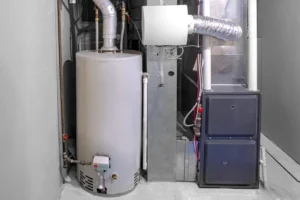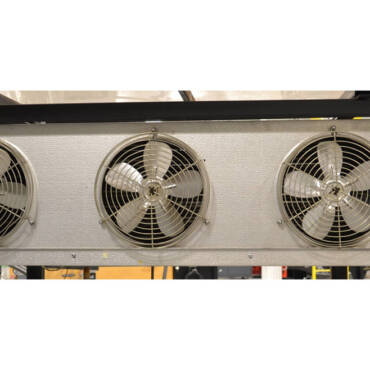Replacing an oil furnace is a significant home investment that most homeowners face unexpectedly. Whether your system has stopped working or repair costs are piling up, knowing what to expect financially helps you make confident decisions without breaking your budget.
Oil furnace replacement cost typically ranges from $6,400 to $9,200, including the unit, installation, and old furnace removal. At Milehi HVAC, we’ve guided hundreds of homeowners through this process, and understanding these costs upfront makes the entire experience smoother and less stressful.
Breakdown of Oil Furnace Replacement Costs
Understanding where your money goes makes the investment less overwhelming. Here’s what’s included in the cost of oil furnace replacement.
The Furnace Unit: Equipment costs range from $2,500 to $7,300 depending on brand and efficiency. Premium brands like Lennox and Carrier cost more, while Rheem and Trane offer solid mid-tier value. High-efficiency models (90-97% AFUE) cost more upfront but save you significantly on monthly heating bills.
Installation Labor: Professional installation runs $1,500 to $2,500. This covers proper sizing, ductwork connections, electrical wiring, and safety testing. HVAC technicians charge $75 to $150 per hour, and installations take 8 to 12 hours.
Old Furnace Removal: Removing and disposing of your old unit costs $250 to $645. Larger furnaces over 120,000 BTUs trend toward the higher end due to their size and weight.
Permits and Inspections: Most areas require permits costing $50 to $300. This ensures your installation meets local building codes and safety standards.
Additional Components: You might need a new thermostat ($50 to $400), ductwork modifications ($500 to $2,000), or oil supply line upgrades. These aren’t always necessary but should be budgeted for potential surprises.
You may read How Often To Change Furnace Filter?
Factors That Impact the Price of Replacing an Oil Furnace
Several key factors determine your final costs. Understanding these helps you anticipate expenses and make informed choices.
BTU Rating and Heating Capacity: British Thermal Units (BTU) measure your furnace’s heating power. A 55,000 BTU unit for a 1,000-square-foot home costs $6,425 to $7,420, while a 150,000 BTU system for 3,000 square feet runs $7,085 to $9,175. Bigger homes need more heating capacity, which increases costs.
Geographic Location: Where you live dramatically affects pricing. Cold climate states like Minnesota or Maine require larger furnaces with higher BTU ratings to combat freezing temperatures. Labor costs also vary urban areas typically charge more than rural locations. If you need furnace replacement Denver, CO, you’ll find competitive pricing due to the area’s established HVAC market, though mountain regions require robust systems for harsh winters.
Efficiency Rating (AFUE): Annual Fuel Utilization Efficiency (AFUE) measures how efficiently your furnace converts fuel to heat. Standard efficiency models (80-89% AFUE) cost $3,500 to $7,500, while high-efficiency units (90-97% AFUE) run $6,000 to $9,175. High-efficiency furnaces cost more initially but can save you over $1,275 in lifetime energy costs according to the Department of Energy.
Brand Selection: Different manufacturers offer varying price points and quality levels. Armstrong furnaces range from $2,500 to $7,300, Bryant runs $3,000 to $7,000, and Carrier costs $3,000 to $6,000. Milehi HVAC works with multiple brands to give you options that fit your budget and performance needs.
Installation Complexity: Homes with outdated ductwork, tight installation spaces, or non-standard configurations increase labor costs. If your oil tank needs replacement or supply lines require upgrading, expect additional expenses of $500 to $2,000.
Seasonal Timing: Installing during off-peak seasons (spring and fall) often yields better pricing. Winter emergency replacements can cost 15-25% more due to high demand and urgent service premiums.
How Do Prices Vary by Type of Oil Furnace?
The oil burner furnace prices depend heavily on efficiency ratings, which directly impact both upfront costs and long-term savings.
Standard Efficiency Oil Furnaces (80-89% AFUE): These units cost $3,500 to $7,500 installed. They’re ideal for warmer climates where heating demands are moderate. If you only run your furnace 3-4 months yearly, a standard efficiency model provides reliable heat without the premium price tag. These work well in southern states or regions with mild winters.
High-Efficiency Oil Furnaces (90-97% AFUE): Premium efficiency models run $6,000 to $9,175. While more expensive upfront, they deliver substantial monthly savings in cold climates. If you live where temperatures regularly drop below freezing, a high-efficiency furnace pays for itself through reduced fuel consumption. For customers seeking furnace replacement Denver, CO, high-efficiency models make excellent sense given Colorado’s cold winters and elevation challenges.
Money-Saving Incentives: High-efficiency furnace buyers can claim a $150 IRS tax credit plus up to $600 in local rebates. These incentives significantly narrow the price gap between standard and high-efficiency models. Milehi HVAC helps customers navigate available rebates to maximize savings.
Long-Term ROI Calculation: A high-efficiency furnace using 10% less fuel saves roughly $200-300 annually in heating costs. Over a 15-year lifespan, that’s $3,000 to $4,500 in savings far exceeding the initial price difference.
What Impact Does Home Size Have on Oil Furnace Prices?
Your home’s square footage directly determines the furnace size you need, which affects the oil burner replacement cost.
Small Homes (1,000 sq. ft.): A 55,000 BTU furnace costs $6,425 to $7,420. Smaller units cost less for equipment but installation labor remains similar, so you’re primarily saving on the unit itself.
Medium Homes (1,500-2,000 sq. ft.): An 80,000 to 100,000 BTU system runs $6,680 to $7,685. This represents the sweet spot where equipment and installation costs balance well for most homeowners.
Large Homes (2,500-3,000 sq. ft.): A 130,000 to 150,000 BTU furnace costs $6,610 to $9,175. Larger homes need powerful systems, and these premium units push toward the higher end of the pricing spectrum.
Factors Beyond Square Footage: Ceiling height, insulation quality, window size, and geographic climate all influence sizing. A poorly insulated 2,000-square-foot home in Vermont needs more heating capacity than a well-insulated same-sized home in Virginia. Milehi HVAC performs detailed heat load calculations to ensure proper sizing oversized furnaces waste energy while undersized units struggle to maintain comfort.
BTU Requirements by Climate Zone: Hot climates (Gulf Coast states) need 20-30 BTU per square foot. Warm climates (Southeast) require 25-35 BTU per square foot. Moderate climates (Mid-Atlantic) need 30-45 BTU per square foot. Cold climates (Mountain regions) require 45-55 BTU per square foot. Freezing climates (Upper Midwest and Northeast) need 50-60 BTU per square foot.
Conclusion
Understanding oil furnace replacement cost empowers you to budget confidently and make informed decisions. With prices ranging from $6,400 to $9,200, the investment significantly improves home comfort and energy efficiency. Milehi HVAC provides transparent pricing, expert installation, and quality equipment that serves you for decades. Ready to discuss your furnace replacement Denver, CO needs? Contact Milehi HVAC today for a detailed quote tailored to your home’s unique requirements.
FAQs
How much does it cost to replace an oil furnace?
The average cost of oil furnace replacement ranges from $6,400 to $9,200, including the unit, professional installation, and old furnace removal. Costs vary based on home size, efficiency rating, brand, and location.
What size oil furnace do I need for my home? Furnace sizing depends on square footage, climate zone, insulation quality, and ceiling height. A 1,000-square-foot home needs approximately 55,000 BTUs, while a 3,000-square-foot home requires 150,000 BTUs. Professional heat load calculations ensure proper sizing.
Should I choose a standard or high-efficiency oil furnace?
High-efficiency furnaces (90-97% AFUE) cost more upfront but save $200-300 annually on heating bills. They’re ideal for cold climates with long heating seasons. Standard efficiency models (80-89% AFUE) suit warmer regions with shorter winters.
How long does oil furnace installation take?
Professional installation typically takes 8 to 12 hours, usually completed in one day. Complex installations requiring ductwork modifications or oil tank replacement may take two days.
Can I get rebates for a new oil furnace?
Yes. High-efficiency oil furnaces qualify for a $150 IRS tax credit and up to $600 in local utility rebates. These incentives significantly reduce the total investment.
What’s the lifespan of a new oil furnace?
Quality oil furnaces last 15 to 20 years with proper annual maintenance. High-efficiency models often last longer due to advanced components and better construction quality.
Is it worth replacing an oil furnace with another oil furnace?
If you already have oil delivery infrastructure and oil prices are reasonable in your area, replacing with another oil furnace makes sense. Modern units are 20-30% more efficient than systems from the 1990s and early 2000s.
Whether you require installation, repair, or maintenance, our technicians will assist you with top-quality service at any time of the day or night. Take comfort in knowing your indoor air quality is the best it can be with MOE heating & cooling services Ontario's solution for heating, air conditioning, and ventilation that’s cooler than the rest.
Contact us to schedule a visit. Our qualified team of technicians, are always ready to help you and guide you for heating and cooling issues. Weather you want to replace an old furnace or install a brand new air conditioner, we are here to help you. Our main office is at Kitchener but we can service most of Ontario's cities
Source link



